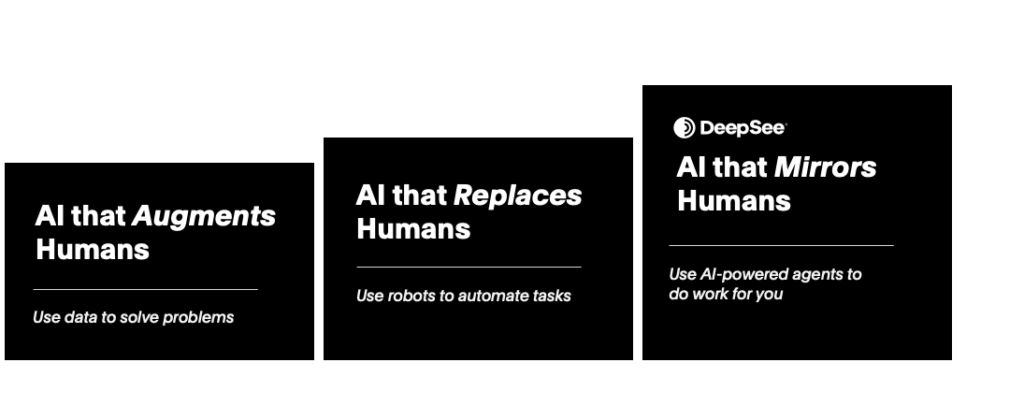First Act: The Alliance of “AI” Magicians
Blog

By Armen Sargsyan
AI has the potential to revolutionize the way we work. Yet, the market is cluttered with a confusing array of AI acronyms and “smoke and mirrors” toolkits, making it hard for investors, prospects, and customers to separate fact from fiction. In 2023, choosing an AI vendor often felt more like falling for a magic trick than making an informed business decision. It was about experimenting with proof of concepts. These vendors, with their polished pitch decks and prototypes, seemed more like magicians than enterprise software application providers. But in 2024, the magic has worn off. The dust has settled. And a new era of Production AI is upon us. The priorities have shifted, the competitive landscape is a raging inferno and customers now demand quick wins along with long-term outcomes.
There’s a fine line between AI Proof of Concept and Production AI

An AI Proof of Concept is the equivalent of a dictionary: informative but not helpful. Imagine asking your AI assistant, “How do magicians perform card tricks?” and receiving a response that delves into the history of magic, the types of playing cards, and the psychology of illusion, yet offers no practical steps or insights into the tricks themselves. It’s like attending a magic show where the magician spends the entire time explaining the theory behind sleight of hand instead of performing any tricks. While the information may be accurate and interesting, it leaves you no closer to learning the secrets of the trade. This is where context and reasoning are critical for Production AI. A truly intelligent assistant would understand that you’re looking for a demonstration or step-by-step guide on performing card tricks. It would provide a clear tutorial or even link to a video from one of the greatest magicians of all time – G.O.B from Arrested Development.
Knowledge > Information
Turning dense information into practical knowledge is the secret sauce for intelligent AI systems. Production AI leverages context to grasp the user’s intent and applies reasoning to deliver actionable, relevant responses, transforming unstructured data into meaningful assistance.
Take applying AI to email spam filters as an example:
AI Proof of Concept:
Scenario: Your inbox is filled with offers for “miracle” weight loss pills.
Response: “Welcome to your inbox. Enjoy the clutter!”
This AI is like a bouncer who lets everyone into the club, even the ones with fake IDs.
Production AI:
Scenario: “Only important emails are in your inbox, and spam is neatly tucked away.”
Response: “I’ve sorted out the junk. Here are the emails that matter.”
This AI is a meticulous personal assistant who knows that the last thing you need is another “Get Rich Quick” scheme.
In the broader context of enterprise AI adoption, there are three approaches:

AI that Augments Humans
AI that augments humans is designed to enhance human capabilities and productivity without taking over their roles entirely. This type of AI acts as an assistant or co-pilot, providing support and improving efficiency. Typically, data-centric platforms such as data lakes, data warehouses, and business intelligence and analytics solutions form the foundation for this approach. While these platforms provide rich intelligence and support key decision-making processes, they often struggle to deliver a holistic, end-to-end solution in complex environments.
AI that Replaces Humans
AI that replaces humans is designed to fully automate tasks that were previously performed by people, leading to significant changes in the workforce landscape. For example, Robotic Process Automation (RPA) enables companies to replace “low-level” work with task automation. While RPA excels at handling simple, repetitive tasks, it often struggles to scale as the complexity of tasks increases.
AI that Mirrors Humans
AI that mirrors humans aims to replicate human behavior by distilling information, applying context, and quickly learning new things. It introduces the capability to support complex reasoning as business requirements grow more intricate. This type of AI is designed to be as human-like as possible, often by stitching together complex enterprise workflows and enriching them with knowledge from domain experts, all while meeting compliance and regulatory needs. We believe the future of enterprise AI lies in designing and delivering compound AI systems that adapt to the dynamic and evolving needs of enterprises.
Developing AI-Powered Performance Cultures Starts with People
People are the driving force behind performance cultures. Their creativity, emotional intelligence, and ability to adapt are irreplaceable assets that shape the success of any organization. While AI can streamline processes and handle repetitive tasks, it is the human touch that fosters innovation and builds meaningful relationships. In our view, AI is the performance engine that supercharges productivity, enabling people to focus on what they do best—strategizing, creating, solving complex problems, and pioneering a new era of learning and development for humans and machines. This synergy between human ingenuity and AI efficiency is what we call Knowledge Process Automation. And that’s the real magic…
